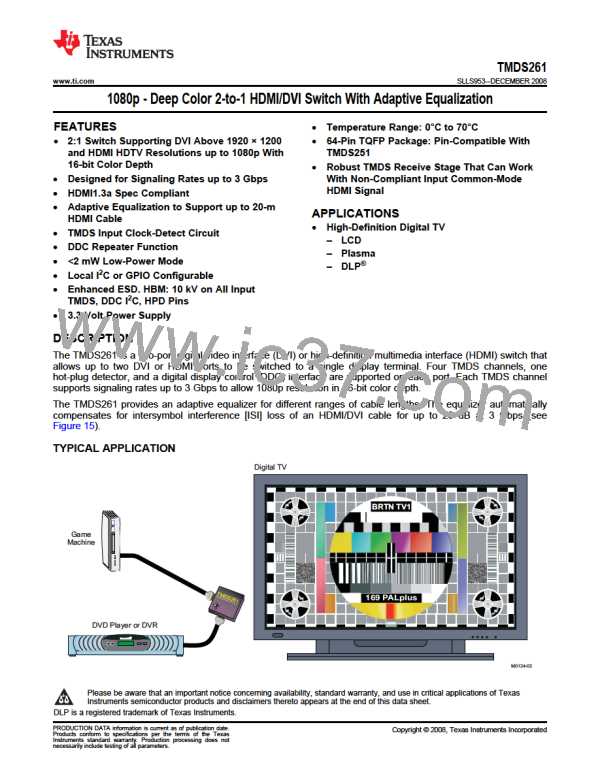TMDS261
www.ti.com ............................................................................................................................................................................................ SLLS953–DECEMBER 2008
A DTV Supporting an Active CEC Link
In Figure 35, the CEC PHY and CEC LOGIC functions are added. The DTV can initiate and/or react to CEC
signals from its remote control or other audio/video products on the same CEC bus. All sources must have their
own CEC physical address to support the full functionality of the CEC link.
A source reads its CEC physical address stored its E-EDID memory after receiving a logic-high from the HPD
feedback. When HPD is high, the sink-assigned CEC physical address should be maintained. Otherwise, when
HPD is low, the source sets CEC physical address value to (F.F.F.F).
Case 1 – AC-Coupled Source (See Figure 35, Port 1)
When the source TMDS lines are ac-coupled or when the source cannot detect the TMDS termination provided
in the connected sink, the indication of the source selection can only come from the HPD signal. The TMDS261
HPD1 pin should be applied directly as the HPD signal back to the source.
Case 2 – DC-Coupled Source (See Figure 36, Port 2)
When the source TMDS lines are dc-coupled, there are two methods to inform the source that it is the active
source to the sink. One is checking the HPD signal from the sink, and the other is checking the termination
condition in the sink.
In a full-CEC operation mode, the HPD signal is set high whether the port is selected or not. The source loads
and maintains the CEC physical address when HPD is high. As soon as HPD goes low, the source loses the
CEC physical address. To keep the CEC physical address to the source, the HPD signal is looping back from the
source-provided 5-V signal through a 1-kΩ pullup resistor in the sink. This method is acceptable in applications
where the HDMI transmitter can detect the receiver termination by current sensing and the receiver has
switchable termination on the TMDS inputs. The internal termination resistors are connected to the termination
voltage when the port is selected, or they are disconnected when the port is not selected. The TMDS261
features switchable termination on the TMDS inputs.
Case 3 – External Logic Control for HPD (See Figure 37, Port 3)
When the HDMI transmitter does not have the capability of detecting the receiver termination, using the HPD
signal as a reference for sensing port selections is the only possible method. External control logic for switching
the connections of the HPD signals between the HPD pins of the TMDS261 and the 5-V signal from the source
provides a good solution.
E-EDID Reading Configurations in Standby Mode
When the TMDS261 is in standby mode operation, S1 = H and S2 = L, all sources can read their E-EDID
memories simultaneously with all HPD pins following HPD_SINK in logic-high. HPD_SINK input low prevents
E-EDID reading in standby-mode operation.
Copyright © 2008, Texas Instruments Incorporated
Submit Documentation Feedback
29
Product Folder Link(s) :TMDS261

 TI [ TEXAS INSTRUMENTS ]
TI [ TEXAS INSTRUMENTS ]